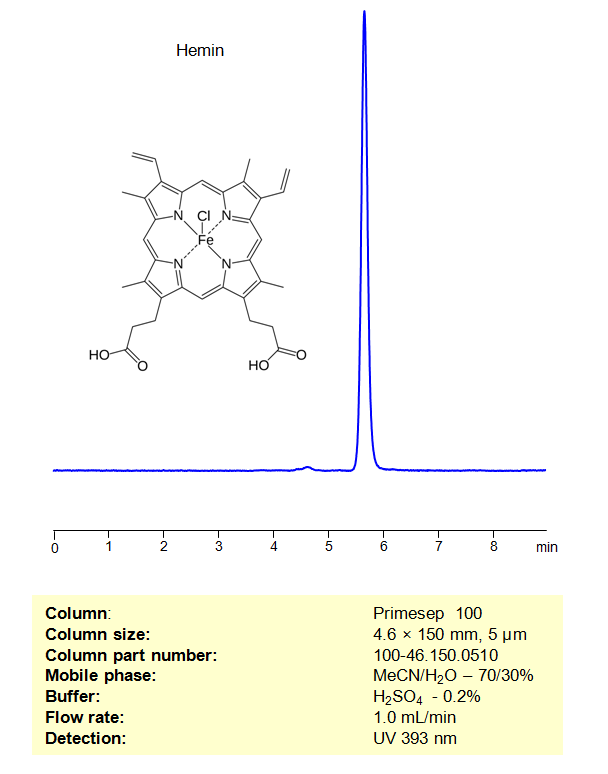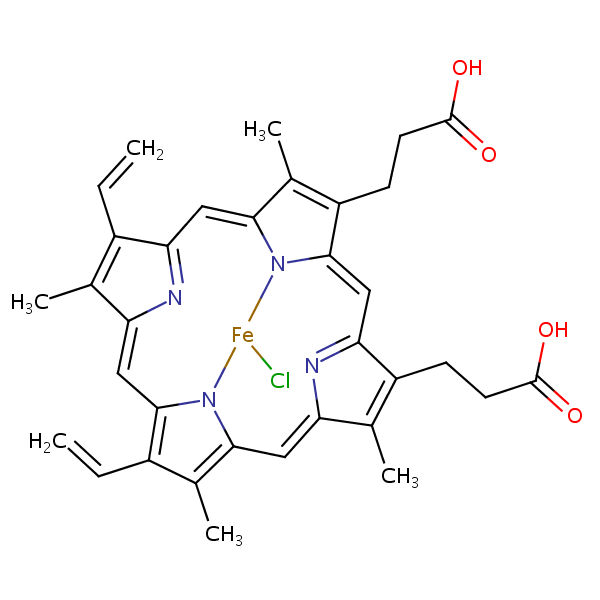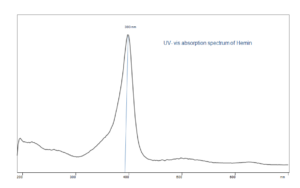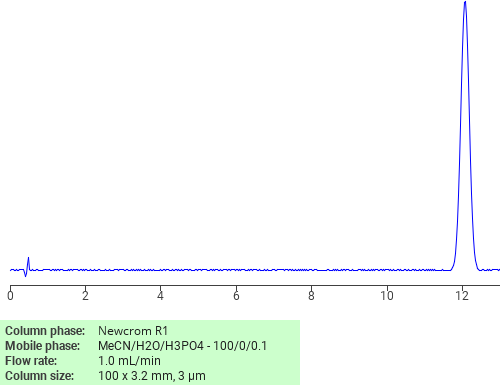| CAS Number | 16009-13-5 |
|---|---|
| Molecular Formula | C34H32ClFeN4O4 |
| Molecular Weight | 651.951 |
| InChI Key | BTIJJDXEELBZFS-HXFTUNQESA-K |
| LogP | 10.4 |
| Synonyms |
|
Applications:
HPLC Method for Analysis of Hemin on Primesep 100 Column
March 6, 2023
HPLC Method for Analysis of Hemin on Primesep 100 by SIELC Technologies
Separation type: Liquid Chromatography Mixed-mode

Hemin is an iron-containing molecule related to hemoglobin and myoglobin, proteins that carry oxygen in blood and muscle, respectively. Specifically, hemin is the ferric (Fe^3+) form of protoporphyrin IX.
Structure: Hemin consists of a protoporphyrin IX ring with a centrally coordinated ferric (Fe^3+) ion. This structure is similar to the heme group found in hemoglobin, myoglobin, and various other heme-containing proteins. The difference between heme and hemin is the oxidation state of the iron and the type of ligands it is bound to.
Biological Role: While hemin itself isn’t a major biological molecule, its close relative, the heme group, plays a critical role in various biological processes. Heme is essential for oxygen transport in hemoglobin and myoglobin and is also a key component of many other proteins and enzymes.
Clinical Relevance: Hemin is used therapeutically as “heme therapy.” It is administered to treat acute porphyria attacks. Porphyrias are a group of rare disorders resulting from a buildup of natural chemicals that produce porphyrin in your body. Administering hemin can help reduce the production of porphyrins.
Laboratory Use: Hemin can be used to induce the expression of heme-oxygenase-1 (HO-1), an enzyme that degrades heme, leading to antioxidant and anti-inflammatory effects. Additionally, in microbiology, hemin is used as a factor to grow certain bacteria like Haemophilus influenzae on chocolate agar.
Hemin can be retained and analyzed using a mixed-mode Primesep 100 column. The mobile phase consists of water, acetonitrile (MeCN), and sulfuric acid (H2SO4). This analytical method allows for UV detection at 393 nm, ensuring high resolution and peak symmetry
High Performance Liquid Chromatography (HPLC) Method for Analysis of Hemin
Condition
| Column | Primesep 100, 4.6 x 150 mm, 5 µm, 100 A, dual ended |
| Mobile Phase | MeCN – 70% |
| Buffer | H2SO4 – 0.2% |
| Flow Rate | 1.0 ml/min |
| Detection | UV 393 nm |
| Peak Retention Time | 5.91 |
| Sample | 1 mg/ml in 0.01M NaOH |
| LOD* | 6 ppb |
*LOD was determined for this combination of instrument, method, and analyte, and it can vary from one laboratory to another even when the same general type of analysis is being performed.
Description
| Class of Compounds | Porphyrin |
| Analyzing Compounds | Hemin |
Application Column
Primesep 100
Column Diameter: 4.6 mm
Column Length: 150 mm
Particle Size: 5 µm
Pore Size: 100 A
Column options: dual ended

Separation of Hemin on Newcrom R1 HPLC column
May 16, 2018
Hemin can be analyzed by this reverse phase (RP) HPLC method with simple conditions. The mobile phase contains an acetonitrile (MeCN), water, and phosphoric acid. For Mass-Spec (MS) compatible applications the phosphoric acid needs to be replaced with formic acid. Smaller 3 µm particles columns available for fast UPLC applications. This liquid chromatography method is scalable and can be used for isolation impurities in preparative separation. It also suitable for pharmacokinetics.
Application Column
Newcrom R1
The Newcrom columns are a family of reverse-phase-based columns. Newcrom A, AH, B, and BH are all mixed-mode columns with either positive or negative ion-pairing groups attached to either short (25 Å) or long (100 Å) ligand chains. Newcrom R1 is a special reverse-phase column with low silanol activity.
Select options




